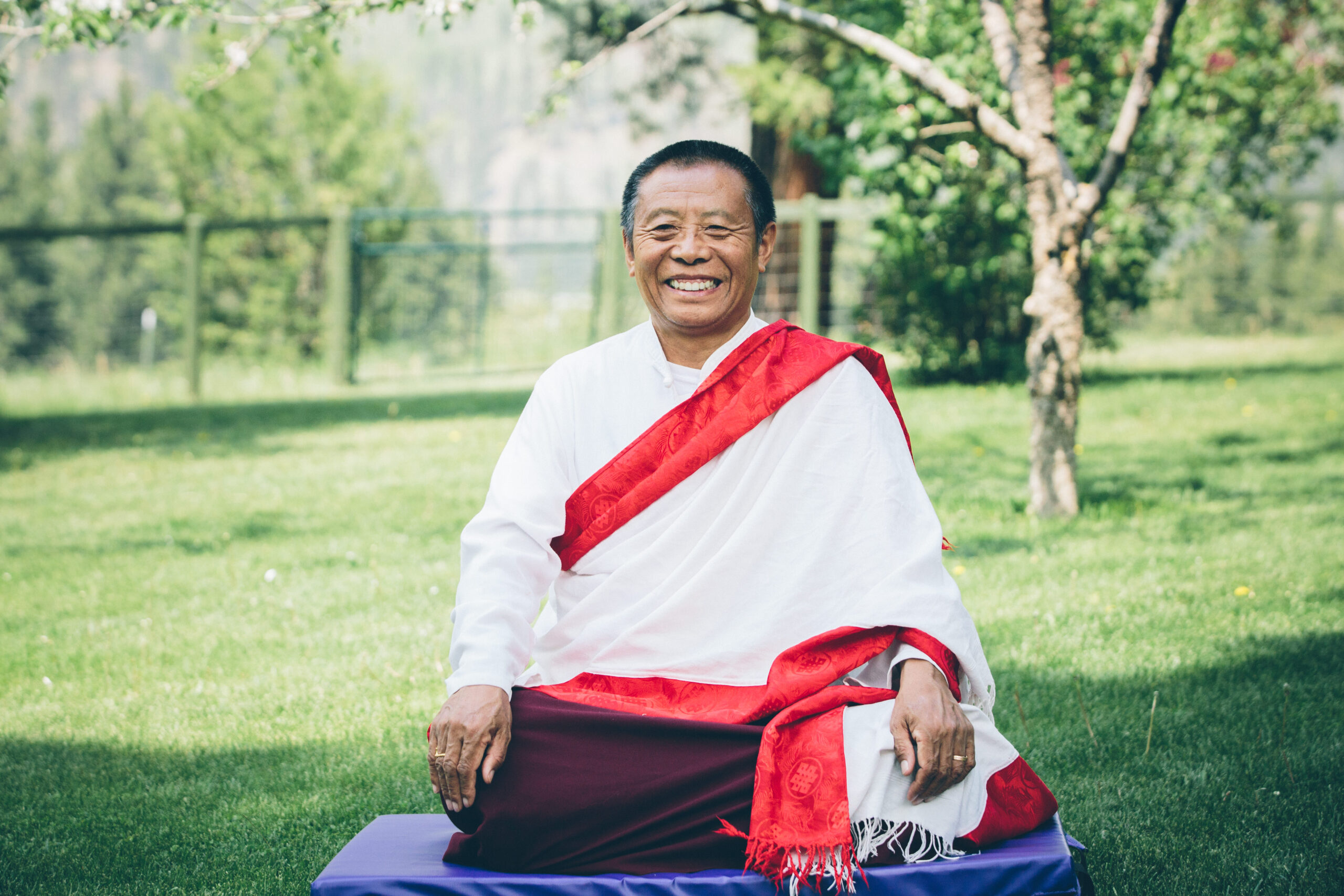Intro to Calm Abiding Meditation
A three-week course for beginners to receive in-depth meditation Tibetan Buddhist instructions, practice with others, and experience the benefits of meditation.
Offered twice a year online or in-person in Missoula, Montana. Our next Introduction to Calm Abiding course will be held in the Fall of 2025.
If you’re interested in attending this teaching in person or online, use the form below to receive program updates.
Who is this course for?
Beginners who want to find out more about meditation.
Those who attended “Stepping into Meditation and Community” and want to learn more about Calm Abiding.
Our minds work from the moment we wake up until we fall asleep. How familiar are we with what’s actually happening in our minds? And how attached are we to the stories that our minds create? When our minds are untrained, we are likely to experience stress, anxiety, emotional pain, and so forth. When we familiarize ourselves with the happenings of our minds, we can uncover and rest in the peaceful state that is always available to us.
In our Intro to Calm Abiding Meditation three-part online and in-person series, we will cultivate habits of seeing and relating to our own inner and outer worlds in a new way that brings us comfort and ease. We will discuss various meditation practices and their benefits while focusing on the practice of Calm Abiding (Shamata) meditation.
We will meet for three consecutive weeks. Each session will last one and a half hours and consist of short periods of instruction followed by many short meditation sessions.

Course Details
Location:
Location: In-person in Missoula or online (Zoom link sent upon registration)
Namchak Buddhist Practice and Retreat
250 Station Drive, 2nd Floor, Missoula, MT, 59801
Dates:
Our next Introduction to Calm Abiding course will be held in the Fall of 2025. Please use the form below to stay updated on course announcements.
Three 1.5-hour sessions. Given the content’s cumulative nature, attendance at all three sessions is highly encouraged. Recordings are available if you cannot attend all three sessions.
Course Overview
What can participants expect?
- Explanations of various kinds of meditations and the specific role of Calm Abiding.
- In-depth instructions and discussions on preparing to meditate.
- Calm Abiding instructions and practice sessions.
- Ideas and advice about integrating meditation into daily life.
What is Calm Abiding?
Calm Abiding meditation is the foundation for all other practices within Tibetan Buddhism. Sometimes spelled Shamatha or Shamata is used to develop our power of attention and bring our thoughts to a peaceful state. Then, we practice resting the mind in that state, which feels like a vacation for our often scattered and distracted minds.
There are various techniques for developing Calm Abiding, and in this course, we will learn and practice the basic techniques found in the Tibetan Buddhist tradition. Calm Abiding serves as the stable ground from which we can move into practices such as Vipassana (Special Insight) meditations on selflessness and emptiness which uproot our habitual patterns and eliminate obscurations that prevent us from seeing reality as it is.
Why meditate?
Among many benefits, regular meditation practice helps us live from a truer perception of reality—the reality that we are all a part of the great ocean of awareness. Through consistent practice, we learn to see the ocean, not just the surface waves. That ocean (including, but not only, the waves) is the true source of all happiness and freedom from suffering. With these methods, we can progress toward that goal—our true home.
Benefits of Meditation
- Improve overall physical, mental, and emotional health
- Decrease stress
- Alleviate anxiety and depression
- Manage chronic pain
- Improve sleep
This program is taught by Justin Kirkwood, a Tibetan translator and Buddhist educator at the Namchak Foundation. He has studied and practiced Buddhist meditation for 20+ years and has served for many years as Namchak Khen Rinpoche’s interpreter for all of his meditation teachings, personal interviews, and more.
Invite a Friend!
Sangha, or community, is one of our favorite elements of the Buddhist path. We’re happy to share that when you register for the Introduction to Calm Abiding Meditation three-week course, you can bring a friend, family member, or loved one to the course for free! Upon registering for the course, you’ll receive a discount code via email (don’t forget to check your spam folder) for your guest to use for free registration.
To attend the course for free, they simply have to register through our website and use the promotional code you received in your email. We look forward to seeing you and your friend at our next course! Please email info@namchak.org if you have any questions.
Frequently Asked Questions
Do I need to be a practicing Buddhist to take this course?
No, no experience is required.
If I am attending in person, what do I bring?
Wear clothes comfortable for meditation and bring a small notebook and a pen.
Is previous meditation experience required to take this course?
No, anyone is welcome to join, from beginners to advanced meditators.
If I miss class, will I have access to the recording?
Yes, recordings will be sent out within a couple of days after each teaching.
Will there be time to meditate together?
Yes, the class is divided into small instructions interspersed with group meditations.
Is Calm Abiding the same as mindfulness?
No, but mindfulness and mindfulness meditation have many different interpretations. Often, mindfulness meditation means “nonjudgmental, open awareness,” which is different from Calm Abiding, a kind of concentration meditation used to bring the mind to a state of focused rest.
Is Calm Abiding the same as Vipassana?
No, in the Tibetan tradition, Calm Abiding is the foundation of Vipassana. Vipassana is insight meditation, and Calm Abiding prepares the mind to gain that insight by focusing and stabilizing it.
What are the benefits of Calm Abiding meditation?
Calm abiding brings your mind’s scattered and distracted energy into focus so that you may focus on one thing calmly and peacefully. The benefits include gaining a general sense of calm, an ability to focus on the task at hand, a feeling of mentally slowing down and seeing your thoughts more clearly. The traditional and foremost benefit is that Calm Abiding prepares the mind for further, more advanced levels of meditation.
What is the difference between the Intro to Calm Abiding Meditation and Stepping into Meditation and Community?
Intro to Calm Abiding is a three-week program that focuses on practicing Calm Abiding. Justin Kirkwood leads each course session and offers a blend of teaching instruction and meditation practice. Stepping into Meditation and Community is a six-week program that introduces various practices, including Calm Abiding, Tonglen or Compassion meditation, and Loving Kindness practice. Led by a facilitator, each live session blends teaching and community discussion. Students spend time meditating during every session.
Our Community Commitments
To co-create a brave, inclusive, anti-oppressive, and learning-centered space in our community, we each agree to:
- Be inclusive of diverse opinions and backgrounds by treating each other with respect and appreciation.
- Commit to words and actions of non-harm within our group interactions.
- Learn by immersing in and committing to the practices at hand.
- Hold personal sharing in confidence.
- Be present, practice mindful listening, and not offer unsolicited advice.
- Allow and invite for equal sharing of voices and the right to pass.
- Take care not to speak for others in the group.
- Assume good intent and come from a place of curiosity and care.
- Come as we are with permission to be “raggedy.”
- Be mindful of and take personal and collective responsibility for our biases, including language that may “other,” “cancel,” or dehumanize any person, groups of people, and/or their experiences.
- Ask for consent before hugging or initiating physical contact during in-person gatherings.
- Use the “Ouch/Oops” tool to address hurtful comments and language in the moment and to allow space for repair.*
*Ouch/Oops . This is a tool for addressing hurtful comments/language in the moment. If someone says something hurtful, anyone can bring attention to it in the moment by saying “Ouch” and then explaining what was hurtful. If it is a word choice issue, give the first speaker the chance to rephrase and try again (remember, it’s okay to be raggedy, and we are all assuming good intent!) When someone says something that comes out wrong or hurts someone else, they should start with “Oops” – first, acknowledge the impact of their words, and then try again. This can also be done outside of the event if someone feels an “Ouch,” but does not feel comfortable sharing it with the group at that time. We aspire for this Sangha to be a place of refuge.
Meet Your Instructor!
 About Justin Kirkwood:
About Justin Kirkwood:
Justin Kirkwood works as a Tibetan translator and Buddhist educator at the Namchak Foundation. He is a Namchak Khen Rinpoche’s close student and serves as his primary interpreter. Justin began his study and practice of Buddhism and the Tibetan language in his home state of Indiana. He was quickly inspired by the idea of learning Buddhism through the Tibetan language in a traditional setting and so he set off with a one-way ticket to India. By living with Tibetans and avoiding the English language at all costs, he quickly became fluent in Tibetan and began his studies in earnest.
After studying essential topics of functions and categories of mind, Buddhist logic and epistemology, and tenet systems at Sera Monastery and the Thosamling Institute (where he also served as interpreter), he ordained and formally entered the Sherabling Institue for Higher Buddhist Studies (Lungrik Jampeling). There he studied The Way of the Bodhisattva, Collected Topics, the Pamanavarttika, the Treasury of Valid Cognition and Reasoning, the Fundamental Verses of the Middle Way, and other branch topics of Buddhist philosophy. Following his studies, he returned his monastic vows and spent another couple of years receiving practice instructions and doing retreats in Tsopema, an important pilgrimage site of Padmasambhava. He finally returned to the United States after eight years in India. Soon after, Justin met Namchak Khen Rinpoche, and both instantly felt a connection as if they were old friends.
They have worked together as teacher and student as well as teacher and interpreter ever since. Over the years, Justin has studied with and served as an interpreter for many other excellent teachers such as Gochen Tulku Sangak Rinpoche, Jigme Namgyal Rinpoche, Lho Ontrul Rinpoche, Chamtrul Rinpoche, Dzogchen Ganor Rinpoche, Khenpo Tsulnam Rinpoche, Drupon Tsering, Lama Wangdor Rinpoche, and Geshe Tsewang Nyima. His teachers in India instructed him that he must teach when returned home. To fulfill their wishes, he teaches meditation and sutra-level Buddhist philosophy as well as assists Namchak Khen Rinpoche with all his programs and students here at the Namchak Foundation.
What People are Saying
Related Programs
Stepping into Meditation and Community
Walking the Path
Join our Community!
Subscribe to our enewsletter to stay up-to-date on retreats, new eCourses, guided meditations,
our retreat ranch, Tibetan Buddhist wisdom, and the Compassion in Action Network.

